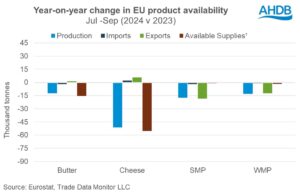Strong demand for value-added products (VAP) and stable consumption of liquid milk will lead to a revenue growth of 14-16 per cent for India’s organised dairy industry this fiscal, said a CRISIL report. It further added that there will be fewer price hikes with raw milk supply improving, and consequently profitability will recover 20-50 basis points. Last fiscal, disruptions in raw milk supply had led to multiple hikes in retail milk prices, pushing up the topline ~19 per cent but impacting profitability. CRISIL Ratings analysed 38 dairies which accounted for ~60 per cent of the organised segment revenue, according to which given the healthy balance sheets, credit profiles of organised dairies will remain strong.
“We believe the strong revenue growth in VAP seen over the past few years will continue. This fiscal, the segment should grow 18-20 per cent and consequently, the share of VAP in overall revenue could rise to ~40 per cent from ~35 per cent four fiscals back. Given that demand from both retail and institutional segments remains strong, the share of VAP will continue to rise. On the other hand, liquid milk revenue will grow 8-10 per cent this fiscal backed by steady demand, said Mohit Makhija, Senior Director, CRISIL Ratings.
It further said that strong demand prospects have encouraged organised dairies to incur capital capital expenditure in both, this fiscal and the next, especially for VAP, which will account for ~60 per cent of the spend. The overall revenue of the industry will grow by 14-16 per cent this fiscal year driven by healthy volume growth of 9-10 per cent and by higher realisations.
“Milk price hikes will be much less intense this fiscal at around Rs 2 per litre compared with a cumulative Rs 5-7 per litre last fiscal, primarily because of two reasons — improvement in raw milk supply on better availability of fodder, and timely vaccination and artificial insemination of cattle. Additionally, the full impact of previous price hikes will improve the profitability of organised dairies by 20-50 bps this fiscal to ~5.5 per cent,” said Anand Kulkarni, Director, CRISIL Ratings.
Last fiscal, milk procurement prices had risen ~14 per cent on account of several challenges on the supply side, such as significant increase in fodder cost, impact on yields due to cattle disease, and disruptions in artificial insemination schedules.
The credit risk profiles are expected to remain stable as capex will be funded by a prudent mix of debt and equity, it said. Gearing is seen comfortable at 1.4 times as on March 31, 2024, versus 1.3 times a year earlier. Interest coverage will remain strong, too, at 9-9.5 times this fiscal, compared with 9.5-10 times last fiscal. Working capital cycle is expected to be stable as healthy demand will limit build-up of skimmed milk powder inventories at the year end.
Going forward, CRISIL said, improvement in supply-side variables will be an important monitorable and a healthy increase in milk collection will be critical for stability in retail milk prices.





